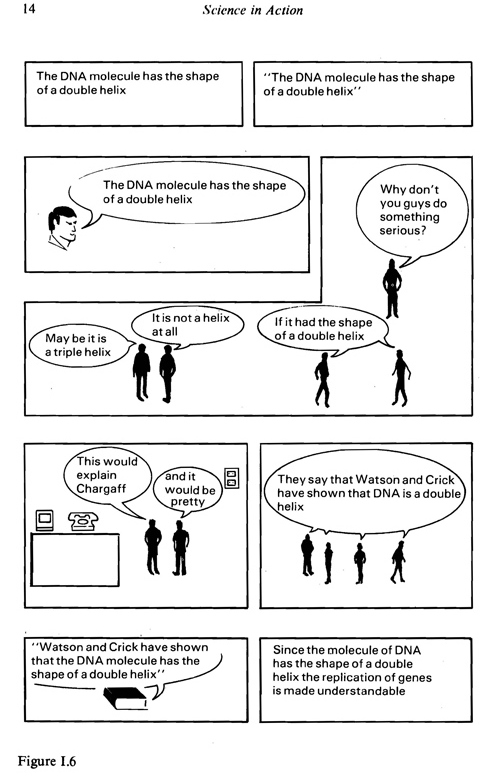Bruno Latour |
Science in action |
| Cambridge, MA: Harvard University Press. 1987. |
 More exactly, what we call 'culture' is the set of elements that appear to be tied together when, and only when, we try to deny a claim or to shake an association... (1987:201) people map for us and for themselves the chains of associations that make-up their sociologics. The main characteristics of these chains is to be unpredictable--for the observer" (author's italics. 1987:202)
More exactly, what we call 'culture' is the set of elements that appear to be tied together when, and only when, we try to deny a claim or to shake an association... (1987:201) people map for us and for themselves the chains of associations that make-up their sociologics. The main characteristics of these chains is to be unpredictable--for the observer" (author's italics. 1987:202)
APPENDIX 1
Rules of Method
Rule 1 We study science in action and not ready made science or technology; to do, so, we either arrive before the facts and machines are blackboxed or we follow the controversies that reopen them. (Introduction)
Rule 2 To determine the objectivity or subjectivity of a claim, the efficiency or perfection of a mechanism, we do not look for their intrinsic qualities but at all the transformations they undergo later in the hands of others.
(Chapter 1)
Rule 3 Since the settlement of a controversy is the cause of Nature's representation, not its consequence, we can never use this consequence, Nature, to explain how and why a controversy has been settled. (Chapter 2)
Rule 4 Since the settlement of a controversy is the cause of Society's
stability, we cannot use Society to explain how and'why a controversy has been settled. We should consider symmetrically the efforts to enrol human and non-human resources. (Chapter 3)
Rule 5 We have to be as undecidedas the various actors we follow as to what
technoscience is made of; every time an inside/outside divide is built, we should study the two sides simultaneously and make the list, no matter how long and heterogeneous, of those who do the work. (Chapter 4)
Rule 6 Confronted with the accusation of irrationality, we look neither at
what rule of logic has been broken, nor at what structure of society could explain the distortion, but to the angle and direction of the observer's displacement, and to the length of the network thus being built. (Chapter 5)
Rule 7 Before attributing any special quality to the mind or to the method of
people, let us examine first the many ways through which inscriptions are
gathered, combined, tied together and sent back. Only if there is something unexplained once the networks have been studied shall we start to speak of cognitive factors. (Chapter 6) (258)
APPENDIX 2
Principles
First principle The fate of facts and machines is in later users' hands; their
qualities are thus a consequence, not a cause, of a collective action. (Chapter
I)
Second principle Scientists and engineers speak in the name of new allies
that they have shaped and enrolled; representatives among other representatives,
they add these unexpected resources to tip the balance of force in
their favour. (Chapter 2)
Third principle Weare never confronted with science, technology and
society, but with a gamut of weaker and stronger associations; thus
understanding what facts and machines are is the same task as
understanding who the people are. (Chapter 3)
Fourth principle The more science and technology have an esoteric content
the further they extend outside;, thus, 'scit:nce and technology' is only a subset
of technoscience. (Chapter 4)
Fifth principle Irrationality is ~Iways an accusation made by someone
building a network over someone else who stands in the way; thus, there is
no Great Divide between minds, but only shorter and longer networks;
harder facts are not the rule but the exception, since they are needed only in a
very few cases to displace others on a large scale out of their usual ways.
(Chapter 5)
Sixth principle History of technoscience is in a large part the history of the
resources scattered along networks to accelerate the mobility, faithfulness,
combination and cohesion of traces that make action at a distance possible.
(Chapter 6)
(p, 259)